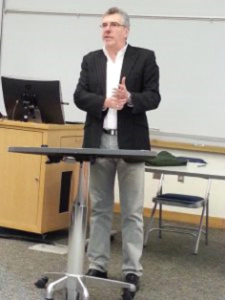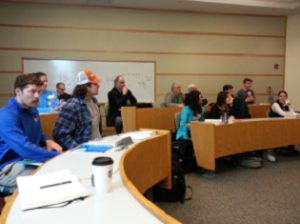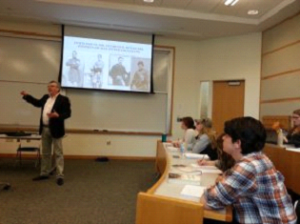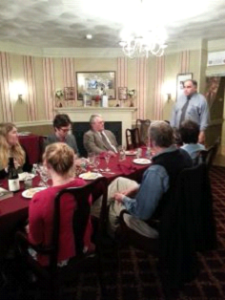In February, Gettysburg College announced that Douglas Egerton, Professor of History, Le Moyne College, had won one of the most prestigious book prizes in history, the Gilder Lehrman Lincoln Prize, for his book Thunder at the Gates: The Black Civil War Regiments That Redeemed America (Basic Books, 2016). The prize “is awarded annually for the finest scholarly work in English on Abraham Lincoln, the American Civil War soldier, or a subject relating to their era.” On April 4, Dr. Egerton, a long-time friend of the Alexander Hamilton Institute for the Study of Western Civilization (AHI), appeared at Hamilton College at the invitation of AHI Executive Director Robert Paquette to present on his prize-winning book in an afternoon class on the Civil War taught by AHI Academic Adviser Maurice Isserman. In the evening at AHI headquarters, Dr. Egerton led a discussion of one chapter of his book, “The Brahmins,” at a Leadership Dinner that included faculty and AHI undergraduate fellows.
James M. McPherson, the Pulitzer Prize-winning Civil War historian, noted that “Thunder at the Gates is the first book to provide a full account of the three black regiments raised by Massachusetts in the Civil War.” The narrative about the 54th’s famous assault on Fort Wagner, as well as other campaigns fought by that regiment with the 55th Regiment and the 5th Cavalry, is “enriched by the stories of more than a dozen individual soldiers and officers, which gives a human and personal dimension to this important work.”
Egerton began his classroom presentation by telling students that the 1989 movie Glory about the 54th’s assault on Fort Wagner, although a moving and powerful film, got much of the historical detail wrong. This included the year the troops arrived at camp, the side from which they attacked the fort, and their status as runaway slaves (most were freemen from New York, Pennsylvania, and Ohio). The soldiers were also housed in heated wooden barracks, and not tents, and were given new uniforms and shoes. In the movie, five of the six main characters are composites; only Robert Gould Shaw, played by Matthew Broderick, was a real person.
What the movie did get right was its presentation of these units as pioneers, as “test cases,” and proofs of deserved status as soldiers and citizens. They understood the “world is watching.” Unlike the white soldiers who wanted to preserve the union, their reasons for fighting revolved around full citizenship status, including equal voting rights, at the time not granted in most northern states. They set out to defeat racism by proving their manhood and saw themselves as “an army of liberation,” and an “army of vengeance.”
As Egerton explained in the Prologue, his book was intended both to clear up misconceptions about the role of the black troops and to present soldiers in all their complexity. The black soldiers’ history has been truncated since 1863 when Louisa May Alcott’s story, “My Contraband,” ended with the death of the main character at Fort Wagner, in the regiment’s second battle. The long-standing misconception that “the saga of the earliest black troops ended only six months after enlistments first began” continued through to the movie Glory.
Egerton’s dramatic narrative tells the story of fourteen men from a variety of backgrounds, who served in the three interconnected regiments. Writing in the Wall Street Journal, reviewer Princeton historian Matthew Karp noted that the 178,000 black troops who served in the Civil War, with the vast majority hailing from the slave states, “remains perhaps the single most revolutionary episode in American history”; they were transformed from “legal property into armed agents of the U.S. government, carrying out a war of liberation against their former masters.” He notes that Egerton in choosing to focus on the pioneering Northern regiments that helped make this mass enlistment possible “goes some distance to reclaim the history of the fighting men themselves” and to recognize the political achievements their service made possible, including the pressure they put on Congress to grant black soldiers equal pay and the authorization in January 1865 to name its first black officer, Lt. Stephen Swails.
While displaying relevant slides, Professor Egerton discussed the varied backgrounds of black troops: Swails, a 30 year-old boatman from Cooperstown whose past had included thievery and impregnating and abandoning a woman; Sergeant James Monroe Trotter, who was born a slave in Mississippi and would become the father of William Trotter, the famed newspaper publisher, co-founder of the NAACP, and civil rights activist; James Gooding, son of a white father who bought his children their freedom and whose letter to President Lincoln objecting to unequal pay remains in the Lincoln papers; Lewis and Charles Douglass, the two sons of Frederick Douglass; Nicholas Said, born in what is now Nigeria and captured there and sold into slavery by Muslim slave traders; and runaway slave William Carney, who became the first black soldier to receive the Medal of Honor.
Questions from students and community members included one about black Confederate soldiers. Egerton replied that he spent about a page and a half on them because Confederate recruitment of slaves did not amount to much. In reality, under the Confederate Congress, only 37 soldiers were trained to fight— without pay— and only during the last two weeks of the war.
Egerton did not want to be accused of “picking 14 choir boys,” so he included the story of Swails who proved himself on the battlefield. He also told the story of a black soldier who was hanged for raping a white woman, a punishment supported by the black soldiers. Egerton had been surprised to learn that white female abolitionists, and not fellow soldiers, tended to oppose the punishment. Honor and integrity were important to the black troops. They were a point of pride to the black press too, which continued the “drumbeat” even as African Americans continued to be discriminated in future wars.
Conversation with Professor Egerton continued later in the afternoon with a reception at the AHI and then a catered dinner in the Brown-Erlanger Presidential Room. In introducing Egerton, Executive Director Robert Paquette noted their long working relationship, which began almost two decades before, and led to a prize-winning essay on the 1822 Denmark Vesey slave conspiracy and then this year to a hefty volume: The Denmark Vesey Affair: A Documentary History (University Press of Florida). Paquette said that he was not surprised that Egerton won the prestigious Lincoln Prize. “Doug has won a basketful of prizes for his scholarship. His productivity is truly impressive; his energy and ingenuity in performing research sets a very high standard indeed.”
Over dessert and coffee, Egerton, described to AHI undergraduate fellows the excitement of historical discovery and the joy in being led by one’s own curiosity to research topics. In this way, he had seemed to happily “stumble from one book to another,” going from his previous book about Reconstruction to Thunder at the Gates. In choosing his subjects, he sought people who were “complicated.” Colonel Shaw, though clearly a war and civil rights hero, initially sometimes used racial slurs when referring to his soldiers, but stopped doing that as he came to know and respect them. Egerton described day-to-day-life of nineteenth-century soldiers serving with members of their own families and communities and the loss felt by small communities when large numbers of their young men fell in war. He also told the personal stories, of Shaw’s “presentiments” about his impending death on the battlefield, and how his mother, a strong abolitionist who had encouraged him to serve, seemed to be haunted by guilt until the time she spoke her own last words, “Rob, Rob, where are you?” Robert Shaw’s 26-year-old widow (they had been married two weeks) never remarried and moved to Switzerland, where she lived in a kind of convent.
The empathy with the characters was made evident in the stories Egerton told students. And it is so in the book that makes a much discussed topic of history come alive. The characters are complex, imperfect, and heroic. Appropriately, the title is taken from a line in a 1913 poem for Colonel Shaw by the African American poet Paul Laurence Dunbar, son of Joshua Dunbar who served in the 55th and Fifth Calvary.
AHI Undergraduate Fellow Phil Parkes, who himself has displayed wide-ranging intellectual curiosity that has garnered a number of awards, referred back to Egerton’s opening remarks. “What I found most interesting,” said Parkes, “was how Dr. Egerton built his academic career in a minimally structured kind of way, following his curiosities where they led him.”
By Mary Grabar, AHI Resident Fellow






Leave A Comment